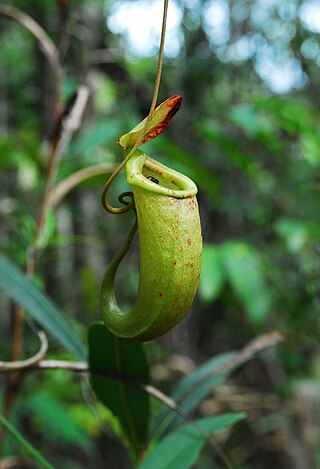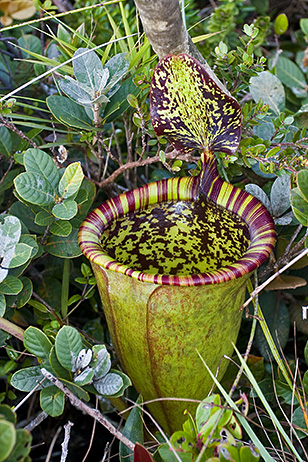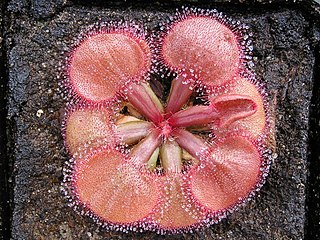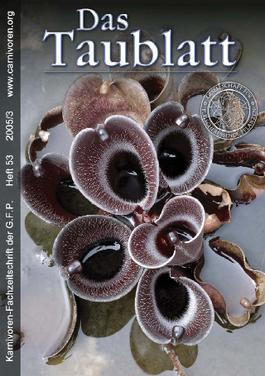
Drosera regia, commonly known as the king sundew, is a carnivorous plant in the sundew genus Drosera that is endemic to a single valley in South Africa. The genus name Drosera comes from the Greek word droseros, meaning "dew-covered". The specific epithet regia is derived from the Latin for "royal", a reference to the "striking appearance" of the species. Individual leaves can reach 70 cm (28 in) in length. It has many unusual relict characteristics not found in most other Drosera species, including woody rhizomes, operculate pollen, and the lack of circinate vernation in scape growth. All of these factors, combined with molecular data from phylogenetic analysis, contribute to the evidence that D. regia possesses some of the most ancient characteristics within the genus. Some of these are shared with the related Venus flytrap (Dionaea muscipula), which suggests a close evolutionary relationship.

Nepenthes villosa, or the villose pitcher-plant, is a tropical pitcher plant endemic to Mount Kinabalu and neighbouring Mount Tambuyukon in northeastern Borneo. It grows at higher elevations than any other Bornean Nepenthes species, occurring at elevations of over 3,200 m (10,500 ft). Nepenthes villosa is characterised by its highly developed and intricate peristome, which distinguishes it from the closely related N. edwardsiana and N. macrophylla.

Nepenthes × kinabaluensis, or the Kinabalu pitcher-plant, is the natural hybrid between N. rajah and N. villosa. It was first collected near Kambarangoh on Mount Kinabalu, Borneo by Lilian Gibbs in 1910 and later mentioned by John Muirhead Macfarlane as "Nepenthes sp." in 1914. Although Macfarlane did not formally name the plant, he noted that "[a]ll available morphological details suggest that this is a hybrid between N. villosa and N. rajah". It was finally described in 1976 by Shigeo Kurata as N. × kinabaluensis. The name was first published in Nepenthes of Mount Kinabalu, but was a nomen nudum at the time as it lacked an adequate description and information on the type specimen. The name was subsequently published validly by Kurata in 1984.

Nepenthes mirabilis, or the common swamp pitcher-plant and tropical pitcher plant, is a carnivorous plant species. By far the most widespread of all Nepenthes, its range covers continental Southeast Asia and all major islands of the Malay Archipelago, stretching from China in the north to Australia in the south. The species exhibits great variability throughout its range. One of the more notable varieties, N. mirabilis var. echinostoma, is endemic to Brunei and Sarawak and possesses an extremely wide peristome.

Adrian Slack was a landscape gardener, plantsman, author and authority on carnivorous plants. He won 5 gold medals at the Chelsea Flower Show, and authored two books: Carnivorous Plants and Insect-Eating Plants and How to Grow Them.

The Carnivorous Plant Newsletter is the official publication of the International Carnivorous Plant Society (ICPS), the largest such organization in the world. It is headquartered in Walnut Creek, California.

Nepenthes glabrata is a tropical pitcher plant endemic to Sulawesi. The species grows in open, high forest at elevations of 1600 to 2100 m. It produces dainty, colourful pitchers reaching only a few centimetres in height. These traps are red speckled on a yellowish background, giving them a "hand painted" appearance.

Nepenthes vogelii is a tropical pitcher plant endemic to Borneo. It is thought to be most closely related to N. fusca.

Nepenthes bellii is a tropical pitcher plant endemic to the Philippine islands of Mindanao and Dinagat, where it grows at elevations of 0–800 m above sea level.

Nepenthes thorelii is a tropical pitcher plant endemic to Indochina. Very little is known about N. thorelii and it is unlikely to have entered cultivation, although various other taxa are often mislabelled as this species in the plant trade. Prior to its rediscovery in 2011, N. thorelii was considered possibly extinct, both in the wild and in cultivation.

Drosera binata, commonly known as the forked sundew or fork-leaved sundew. It is a large, perennial sundew native to Australia and New Zealand. The specific epithet is Latin for "having pairs" - a reference to the leaves, which are dichotomously divided or forked.

Drosera indica is an insectivorous plant, a sundew native to tropical countries throughout the world, from Asia to Africa, but absent from the neotropics. Together with Australian endemic species D. aquatica, D. aurantiaca, D. barrettorum, D. cucullata, D. finlaysoniana, D. fragrans, D. glabriscapa, D. hartmeyerorum, D. nana, D. serpens it makes up the section Arachnopus.

Nepenthes attenboroughii, or Attenborough's pitcher plant, is a montane species of carnivorous pitcher plant of the genus Nepenthes. It is named after the celebrated broadcaster and naturalist Sir David Attenborough, who is a keen enthusiast of the genus. The species is characterised by its large and distinctive bell-shaped lower and upper pitchers and narrow, upright lid. The type specimen of N. attenboroughii was collected on the summit of Mount Victoria, an ultramafic mountain in central Palawan, the Philippines.

Alastair S. Robinson is a taxonomist and field botanist specialising in the carnivorous plant genus Nepenthes, for which he is regarded as a world authority. He is currently Manager Biodiversity Services at the National Herbarium of Victoria, Royal Botanic Gardens Melbourne, where he oversees identification botany services, the Library and Artwork components of the State Botanical Collection, and the botanical journal Muelleria, a peer-reviewed scientific journal on botany published by the Royal Botanic Gardens Victoria, for which he is Editor in Chief.

Drosera falconeri is a carnivorous plant in the family of Droseraceae. It is endemic to the Northern Territory of Australia.

Das Taublatt is a twice-yearly German-language periodical based in Bochum and the official publication of Gesellschaft für Fleischfressende Pflanzen, a carnivorous plant society based in Germany. Typical articles include matters of horticultural interest, field reports, and new taxon descriptions. The journal was established in 1984. It publishes in full colour on glossy paper, with each issue numbering around 52 pages.

Planta Carnivora is a biannual periodical and the official publication of The Carnivorous Plant Society of the United Kingdom. Typical articles include matters of horticultural interest, field reports, and news of plant discoveries. The journal was established in 1980 and was called The Carnivorous Plant Society Journal until 2009; the following year it was combined with the society's newsletter to form Planta Carnivora. Issues are published in spring and autumn.

AIPC Magazine is a quarterly Italian-language periodical and the official publication of Associazione Italiana Piante Carnivore (AIPC), a carnivorous plant society based in Rome, Italy. Typical articles include matters of horticultural interest, field reports, and plant descriptions. The periodical was established as AIPC News by Marcello Catalano in January 1998, at a time when the newly founded AIPC had only around 30 members.


















